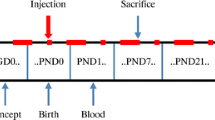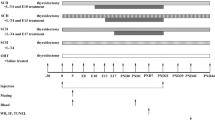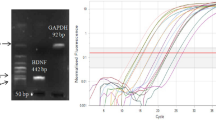Abstract
Thyroid disorders impair various functions of the hippocampus where thyroid hormone receptors are localized in the brain. Hyper and hypothyroidism are associated with large changes in brain oxidative stress. Apolipoprotein D (APOD) is a conserved glycoprotein that increased in response to oxidative stress in the brain and has been suggested function as an antioxidant in the brain. Thus, the goal of this work was to explore the effect of maternal hypo- and hyperthyroidism on the Apod expression in the pup’s brain regarding changes in oxidative stress. For induction hypo and hyperthyroidism in adult female rats, 100 ppm propylthiouracil (PTU) and 8 ppm levothyroxine administrated 1 month before copulation to the week 3 after delivery in drinking water. The hippocampal region of rat pups was isolated and used for immunohistochemistry and quantitative RT-PCR on postnatal day (PND)5, PND10 and PND20. Results revealed that APOD over-expressed in both hypo- and hyperthyroid groups on PND5, PND10, and PND20. There was a proportional increase between the Apod expression and oxidative stress in the hyperthyroid group but not the hypothyroid in different days. Regarding the wide functions of thyroid hormones, oxidative stress does not suggest to be the only mechanism that involves Apod gene expression in thyroid disturbances.







Similar content being viewed by others
Abbreviations
- THs:
-
Thyroid hormones
- Apod :
-
Apolipoprotein D mRNA
- APOD:
-
Apolipoprotein D protein
- PND:
-
Postnatal day
- PTU:
-
Propylthiouracil
- TAC:
-
Total antioxidant capacity
- MDA:
-
Malondialdehyde
- OS:
-
Oxidative stress
- TBA:
-
Thiobarbituric acid
- PBS:
-
Phosphate buffered saline
- TBS:
-
Tris-buffered saline
- BSA:
-
Bovine serum albumin
- DAB:
-
3,3-Diaminobenzidine
- HRP:
-
Horseradish peroxidase
- DG:
-
Dentate gyrus
References
Moog NK, Entringer S, Heim C, Wadhwa PD, Kathmann N, Buss C (2017) Influence of maternal thyroid hormones during gestation on fetal brain development. Neuroscience 342:68–100
Göbel A, Heldmann M, Göttlich M, Dirk A-L, Brabant G, Münte TF (2015) Effect of experimental thyrotoxicosis on brain gray matter: a voxel-based morphometry study. Eur Thyr J 4(Suppl 1):113–118
Rami A, Patel A, Rabie A (1986) Thyroid hormone and development of the rat hippocampus: morphological alterations in granule and pyramidal cells. Neuroscience 19(4):1217–1226
O'Shaughnessy KL, Thomas SE, Spring SR, Ford JL, Ford RL, Gilbert ME (2019) A transient window of hypothyroidism alters neural progenitor cells and results in abnormal brain development. Sci Rep 9(1):4662–4662. https://doi.org/10.1038/s41598-019-40249-7
Gilbert M, Sui L, Walker M, Anderson W, Thomas S, Smoller S, Schon J, Phani S, Goodman J (2007) Thyroid hormone insufficiency during brain development reduces parvalbumin immunoreactivity and inhibitory function in the hippocampus. Endocrinology 148(1):92–102
Madeira MD, Paula-Barbosa MM (1993) Reorganization of mossy fiber synapses in male and female hypothyroid rats: a stereological study. J Comp Neurol 337(2):334–352. https://doi.org/10.1002/cne.903370213
Markowski VP, Zareba G, Stern S, Cox C, Weiss B (2001) Altered operant responding for motor reinforcement and the determination of benchmark doses following perinatal exposure to low-level 2,3,7,8-tetrachlorodibenzo-p-dioxin. Environ Health Perspect 109(6):621–622
Madeira M, Sousa N, Lima-Andrade M, Calheiros F, Cadete-Leite A, Paula-Barbosa M (1992) Selective vulnerability of the hippocampal pyramidal neurons to hypothyroidism in male and female rats. J Comp Neurol 322(4):501–518
Lavado-Autric R, Ausó E, García-Velasco JV, del Carmen Arufe M, del Rey FE, Berbel P, de Escobar GM (2003) Early maternal hypothyroxinemia alters histogenesis and cerebral cortex cytoarchitecture of the progeny. J Clinic Investig 111(7):1073–1082
Taşkın E, Artis AS, Bitiktas S, Dolu N, Liman N, Süer C (2011) Experimentally induced hyperthyroidism disrupts hippocampal long-term potentiation in adult rats. Neuroendocrinology 94(3):218–227
Ahmed OM, El-Gareib A, El-Bakry A, El-Tawab SA, Ahmed R (2008) Thyroid hormones states and brain development interactions. Int J Dev Neurosci 26(2):147–209
Rego AC, Oliveira CR (2003) Mitochondrial dysfunction and reactive oxygen species in excitotoxicity and apoptosis: implications for the pathogenesis of neurodegenerative diseases. Neurochem Res 28(10):1563–1574
Mayer L, Romic Ž, Škreb F, Bačic-Vrća V, Čepelak I, Žanic-Grubišić T, Kirin M (2004) Antioxidants in patients with hyperthyroidism. Clin Chem Lab Med 42(2):154–158
Cano-Europa E, Perez-Severiano F, Vergara P, Ortiz-Butron R, Rios C, Segovia J, Pacheco-Rosado J (2008) Hypothyroidism induces selective oxidative stress in amygdala and hippocampus of rat. Metab Brain Dis 23(3):275–287. https://doi.org/10.1007/s11011-008-9099-0
Domingues JT, Cattani D, Cesconetto PA, Nascimento de Almeida BA, Pierozan P, dos Santos K, Razzera G, Silva FRMB, Pessoa-Pureur R, Zamoner A (2018) Reverse T3 interacts with αvβ3 integrin receptor and restores enzyme activities in the hippocampus of hypothyroid developing rats: insight on signaling mechanisms. Mol Cell Endocrinol 470:281–294. https://doi.org/10.1016/j.mce.2017.11.013
Butler TR, Smith KJ, Self RL, Braden BB, Prendergast MA (2011) Neurodegenerative effects of recombinant HIV-1 Tat(1–86) are associated with inhibition of microtubule formation and oxidative stress-related reductions in microtubule-associated protein-2(a, b). Neurochem Res 36(5):819–828. https://doi.org/10.1007/s11064-011-0409-2
Salazar P, Cisternas P, Codocedo JF (1863) Inestrosa NC (2017) Induction of hypothyroidism during early postnatal stages triggers a decrease in cognitive performance by decreasing hippocampal synaptic plasticity. Biochim Biophys Acta (BBA)-Mol Basis Dis 4:870–883. https://doi.org/10.1016/j.bbadis.2017.01.002
Rassart E, Bedirian A, Do Carmo S, Guinard O, Sirois J, Terrisse L, Milne R (2000) Apolipoprotein d. Biochim Biophys Acta (BBA)-Protein Struct Mol Enzymol 1482(12):185–198
Bajo-Grañeras R, Sanchez D, Gutierrez G, González C, Do Carmo S, Rassart E, Ganfornina MD (2011) Apolipoprotein D alters the early transcriptional response to oxidative stress in the adult cerebellum. J Neurochem 117(6):949–960
Bhatia S, Jenner AM, Li H, Ruberu K, Spiro AS, Shepherd CE, Kril JJ, Kain N, Don A, Garner B (2013) Increased apolipoprotein D dimer formation in Alzheimer's disease hippocampus is associated with lipid conjugated diene levels. J Alzheimer's Dis 35(3):475–486
Zhou Y, Wang L, Li R, Liu M, Li X, Su H, Xu Y, Wang H (2018) Secreted glycoprotein BmApoD1 plays a critical role in anti-oxidation and anti-apoptosis in Bombyx mori. Biochem Biophys Res Commun 495(1):839–845
Dassati S, Waldner A, Schweigreiter R (2014) Apolipoprotein D takes center stage in the stress response of the aging and degenerative brain. Neurobiol Aging 35(7):1632–1642
Ganfornina MD, Do Carmo S, Lora JM, Torres-Schumann S, Vogel M, Allhorn M, González C, Bastiani MJ, Rassart E, Sanchez D (2008) Apolipoprotein D is involved in the mechanisms regulating protection from oxidative stress. Aging Cell 7(4):506–515
Bhatia S, Knoch B, Wong J, Kim WS, Else PL, Oakley AJ, Garner B (2012) Selective reduction of hydroperoxyeicosatetraenoic acids to their hydroxy derivatives by apolipoprotein D: implications for lipid antioxidant activity and Alzheimer's disease. Biochem J 442(3):713–721
Li H, Ruberu K, Muñoz SS, Jenner AM, Spiro A, Zhao H, Rassart E, Sanchez D, Ganfornina MD, Karl T (2015) Apolipoprotein D modulates amyloid pathology in APP/PS1 Alzheimer's disease mice. Neurobiol Aging 36(5):1820–1833
Do Carmo S, Levros LC Jr, Rassart E (2007) Modulation of apolipoprotein D expression and translocation under specific stress conditions. Biochim Biophys Acta 1773(6):954–969. https://doi.org/10.1016/j.bbamcr.2007.03.007
Alvarez ML, Barbón JJ, González LO, Abelairas J, Boto A, Vizoso FJ (2003) Apolipoprotein D expression in retinoblastoma. Ophthalmic Res 35(2):111–116
Bradley DJ, Young WS, Weinberger C (1989) Differential expression of alpha and beta thyroid hormone receptor genes in rat brain and pituitary. Proc Natl Acad Sci 86(18):7250–7254. https://doi.org/10.1073/pnas.86.18.7250
Terrisse L, Seguin D, Bertrand P, Poirier J, Milne R, Rassart E (1999) Modulation of apolipoprotein D and apolipoprotein E expression in rat hippocampus after entorhinal cortex lesion. Brain Res Mol Brain Res 70(1):26–35
Shafiee SM, Vafaei AA, Rashidy-Pour A (2016) Effects of maternal hypothyroidism during pregnancy on learning, memory and hippocampal BDNF in rat pups: beneficial effects of exercise. Neuroscience 329:151–161
Bradford MM (1976) A rapid and sensitive method for the quantitation of microgram quantities of protein utilizing the principle of protein-dye binding. Anal Biochem 72(1–2):248–254
Ohkawa H, Ohishi N, Yagi K (1978) Reaction of linoleic acid hydroperoxide with thiobarbituric acid. J Lipid Res 19(8):1053–1057
Benzie IF, Strain JJ (1996) The ferric reducing ability of plasma (FRAP) as a measure of “antioxidant power”: the FRAP assay. Anal Biochem 239(1):70–76
Sanchez D, López-Arias B, Torroja L, Canal I, Wang X, Bastiani MJ, Ganfornina MD (2006) Loss of glial lazarillo, a homolog of apolipoprotein D, reduces lifespan and stress resistance in Drosophila. Curr Biol 16(7):680–686
Royland JE, Parker JS, Gilbert ME (2008) A genomic analysis of subclinical hypothyroidism in hippocampus and neocortex of the developing rat brain. J Neuroendocrinol 20(12):1319–1338. https://doi.org/10.1111/j.1365-2826.2008.01793.x
Shiraki A, Saito F, Akane H, Akahori Y, Imatanaka N, Itahashi M, Yoshida T, Shibutani M (2016) Gene expression profiling of the hippocampal dentate gyrus in an adult toxicity study captures a variety of neurodevelopmental dysfunctions in rat models of hypothyroidism. J Appl Toxicol 36(1):24–34. https://doi.org/10.1002/jat.3140
Mutch DM, Berger A, Mansourian R, Rytz A, Roberts M-A (2002) The limit fold change model: a practical approach for selecting differentially expressed genes from microarray data. BMC Bioinform 3(1):17. https://doi.org/10.1186/1471-2105-3-17
Rahaman SO, Ghosh S, Mohanakumar K, Das S, Sarkar PK (2001) Hypothyroidism in the developing rat brain is associated with marked oxidative stress and aberrant intraneuronal accumulation of neurofilaments. Neurosc Res 40(3):273–279
Cano-Europa E, Pérez-Severiano F, Vergara P, Ortiz-Butrón R, Ríos C, Segovia J, Pacheco-Rosado J (2008) Hypothyroidism induces selective oxidative stress in amygdala and hippocampus of rat. Metab Brain Dis 23(3):275–287
Goswami K, Nandakumar DN, Koner BC, Bobby Z, Sen SK (2003) Oxidative changes and desialylation of serum proteins in hyperthyroidism. Clin Chimica acta 337(1–2):163–168
Guerra LN, de Molina MdCR, Miler EA, Moiguer S, Karner M, Burdman JA (2005) Antioxidants and methimazole in the treatment of Graves' disease: effect on urinary malondialdehyde levels. Clin Chimica Acta 352(1–2):115–120
Cetinkaya A, Kurutas EB, Buyukbese MA, Kantarceken B (2005) Bulbuloglu E (2005) Levels of malondialdehyde and superoxide dismutase in subclinical hyperthyroidism. Mediat Inflamm 1:57–59
Kowalczyk E, Kopff M, Kopff A, Rudnicka M, Błaszczyk J (2003) The influence of hyperthyroidism on selected parameters of oxidant-antioxidant balance on animal model. Polskie Arch Med Wewn 110(2):837–841
Mogulkoc R, Baltaci A, Aydin L, Oztekin E, Sivrakaya A (2005) The effect of thyroxine administration on lipid peroxidation in different tissues of rats with hypothyroidism. Acta Physiol Hung 92(1):39–46
Pascua Maestro R, González E, Lillo C, Ganfornina MD, Falcon-Perez JM, Sanchez D (2018) Extracellular vesicles secreted by astroglial cells transport Apolipoprotein D to neurons and mediate neuronal survival upon oxidative stress. Frontiers in cellular neuroscience 12:526
Do Carmo S, Séguin D, Milne R, Rassart E (2002) Modulation of apolipoprotein D and apolipoprotein E mRNA expression by growth arrest and identification of key elements in the promoter. J Biol Chem 277(7):5514–5523
Kim WS, Wong J, Weickert CS, Webster MJ, Bahn S, Garner B (2009) Apolipoprotein-D expression is increased during development and maturation of the human prefrontal cortex. J Neurochem 109(4):1053–1066. https://doi.org/10.1111/j.1471-4159.2009.06031.x
Najyb O, Do Carmo S, Alikashani A, Rassart E (2017) Apolipoprotein D overexpression protects against kainate-induced neurotoxicity in mice. Mol Neurobiol 54(6):3948–3963. https://doi.org/10.1007/s12035-016-9920-4
Desmarais F, Bergeron KF, Lacaille M, Lemieux I, Bergeron J, Biron S, Rassart E, Joanisse DR, Mauriege P, Mounier C (2018) High ApoD protein level in the round ligament fat depot of severely obese women is associated with an improved inflammatory profile. Endocrine 61(2):248–257. https://doi.org/10.1007/s12020-018-1621-5
Nam SM, Kim JW, Yoo DY, Jung HY, Chung JY, Kim DW, Hwang IK, Yoon YS (2018) Hypothyroidism increases cyclooxygenase-2 levels and pro-inflammatory response and decreases cell proliferation and neuroblast differentiation in the hippocampus. Mol Med Rep 17(4):5782–5788. https://doi.org/10.3892/mmr.2018.8605
Levros LC Jr, Labrie M, Charfi C, Rassart E (2013) Binding and repressive activities of apolipoprotein E3 and E4 isoforms on the human ApoD promoter. Mol Neurobiol 48(3):669–680. https://doi.org/10.1007/s12035-013-8456-0
Roman C, Fuior EV, Trusca VG, Kardassis D, Simionescu M, Gafencu AV (2015) Thyroid hormones upregulate apolipoprotein E gene expression in astrocytes. Biochem Biophys Res Commun 468(1–2):190–195. https://doi.org/10.1016/j.bbrc.2015.10.132
Lim W, Bae H, Song G (2016) Differential expression of apolipoprotein D in male reproductive system of rats by high-fat diet. Andrology 4(6):1115–1122. https://doi.org/10.1111/andr.12250
Acknowledgements
The research presented in this article is part of the dissertation of Marziyeh Salami, to receive a master’s degree in biochemistry. Semnan University of Medical Sciences sponsored this project under the project no. 1190.
Author information
Authors and Affiliations
Corresponding author
Ethics declarations
Conflict of interest
We declare that there are no conflicts of interests exist.
Ethical Approval
The ethics committee of Semnan university of medical sciences accredited the study (approval ID: IR. SEMUMS. REC.1395. 215). All experiments and animal care performed based on approved international and national guidelines.
Research Involving Human and Animal Participants
Authors have performed no studies on the human participants in this study.
Additional information
Publisher's Note
Springer Nature remains neutral with regard to jurisdictional claims in published maps and institutional affiliations.
Rights and permissions
About this article
Cite this article
Salami, M., Bandegi, A.R., Sameni, H.R. et al. Hippocampal Up-Regulation of Apolipoprotein D in a Rat Model of Maternal Hypo- and Hyperthyroidism: Implication of Oxidative Stress. Neurochem Res 44, 2190–2201 (2019). https://doi.org/10.1007/s11064-019-02859-5
Received:
Revised:
Accepted:
Published:
Issue Date:
DOI: https://doi.org/10.1007/s11064-019-02859-5




